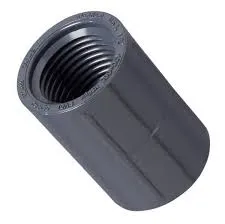-
Cangzhou Yulong Steel Co., Ltd.
-
Phone:
+86 13303177267 -
Email:
admin@ylsteelfittings.com

Nov . 27, 2024 01:32 Back to list
Understanding Rolled and Welded Steel Pipes for Modern Construction Applications
Rolled and Welded Steel Pipe Construction's Backbone
In the realm of construction and manufacturing, rolled and welded steel pipes have emerged as indispensable components, providing strength, durability, and versatility to various applications. By understanding the process and benefits of these steel pipes, one can appreciate their pivotal role in modern infrastructure.
The Manufacturing Process
Rolled and welded steel pipe is produced through a combination of rolling and welding techniques. Initially, steel sheets or plates are rolled into cylindrical shapes, a process known as hot rolling. This technique involves heating the steel above its re-crystallization temperature to make it malleable, allowing it to be shaped into a pipe. The next step involves welding the edges of the steel plate together, forming a continuous pipe. This can be achieved through various welding methods, including electric resistance welding (ERW), submerged arc welding (SAW), and others, depending on the intended use and specifications required.
The quality of the rolled and welded steel pipe heavily relies on the materials used and the precision of the manufacturing process. Advanced technology and rigorous quality control measures ensure that the pipes meet industry standards for various applications. One of the key advantages of this manufacturing process is that it allows for the production of large-diameter pipes, which are crucial in industries such as oil and gas, water supply, and construction.
Applications in Various Industries
Rolled and welded steel pipes find applications across a wide range of industries, including construction, oil and gas, water management, and chemical processing. In the construction sector, these pipes are often utilized for structural components, scaffolding, and supports due to their strength and ability to withstand heavy loads. Their reliability is critical in building infrastructures such as bridges, highways, and skyscrapers.
In the oil and gas industry, the demand for durable, high-quality pipes is paramount for transporting crude oil, natural gas, and other petroleum products. Rolled and welded steel pipes are employed in pipelines that span vast distances, connecting extraction sites to refineries and distribution points. The ability to customize the size and thickness of these pipes ensures they can accommodate the varying pressures and environmental conditions encountered throughout their journey.
Water management systems also benefit significantly from rolled and welded steel pipes. These pipes are used for transporting potable water, sewage, and stormwater. Their corrosion resistance and structural integrity enable them to perform effectively even under harsh conditions, contributing to the sustainability and reliability of urban infrastructure.
rolled and welded steel pipe

Advantages of Rolled and Welded Steel Pipe
The advantages of rolled and welded steel pipes are plentiful. Firstly, they offer exceptional strength-to-weight ratios, making them both robust and manageable. This is particularly important in construction, where weight considerations can influence design and material selection.
Secondly, the ability to produce these pipes in large diameters allows for efficient transportation and distribution of fluids and gases over long distances. This scalability makes rolled and welded steel pipes an attractive option for large-scale projects.
Another significant benefit is the cost-effectiveness of the manufacturing process. Compared to other methods of pipe production, rolling and welding offer a more economical solution without compromising quality. This is especially beneficial for projects where budget constraints are a critical factor.
Challenges and Future Trends
Despite their many advantages, the rolled and welded steel pipe industry faces challenges, including fluctuations in raw material prices and increasing competition from alternative materials such as plastic and composite pipes. To sustain its market position, the industry must innovate continuously. Emerging trends, such as the incorporation of advanced coating techniques to enhance corrosion resistance and the adoption of automated manufacturing processes, are already underway.
The future of rolled and welded steel pipes is promising, particularly as infrastructure projects around the world expand. As sustainability becomes a more significant concern, the industry is also exploring recycling practices and the life-cycle management of steel products, aligning with global environmental goals.
In conclusion, rolled and welded steel pipes are a cornerstone of modern construction and various industrial applications. Their strength, versatility, and cost-effectiveness ensure that they will remain vital components in the infrastructure of tomorrow. Understanding their production, applications, and benefits sheds light on why these materials are so integral to our built environment.
Latest news
-
ANSI 150P SS304 SO FLANGE
NewsFeb.14,2025
-
ASTM A333GR6 STEEL PIPE
NewsJan.20,2025
-
ANSI B16.5 WELDING NECK FLANGE
NewsJan.15,2026
-
ANSI B16.5 SLIP-ON FLANGE
NewsApr.19,2024
-
DIN86044 PLATE FLANGE
NewsApr.19,2024
-
DIN2527 BLIND FLANGE
NewsApr.12,2024
-
JIS B2311 Butt-Welding Fittings LR/SR 45°/90° /180°Seamless/Weld
NewsApr.23,2024
-
DIN2605-2617 Butt-Welding Fittings LR/SR 45°/90°/180° Seamless/Weld
NewsApr.23,2024











